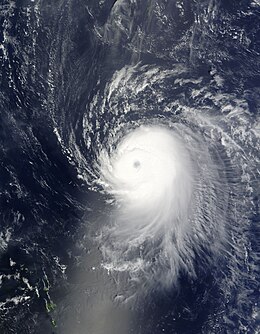Hurricane Ike
Hurricane Ike was one of the most damaging tropical cyclones in United States history, having caused about $38 billion dollars in damage. It was the sixth-costliest Atlantic hurricane in U.S. history. Hurricane Ike was the ninth named storm, fifth hurricane, third major hurricane and the most-intense hurricane of 2008 in terms of pressure. Ike may have caused up to 195 deaths. Most deaths happened in Haiti and the U.S. together. Haiti was still recovering from Tropical Storm Fay, Hurricane Gustav, and Hurricane Hanna.[1]
| Category 4 major hurricane (SSHWS/NWS) | |
 Hurricane Ike near peak intensity on September 4 | |
| Formed | September 1, 2008 |
|---|---|
| Dissipated | September 14, 2008 |
| Highest winds | 1-minute sustained: 145 mph (230 km/h) |
| Lowest pressure | 935 mbar (hPa); 27.61 inHg |
| Damage | $38 billion (2008 USD) |
| Areas affected | Turks and Caicos, Bahamas, Haiti, Dominican Republic, Cuba, Florida Keys, Mississippi, Louisiana, Texas, Mississippi Valley, Ohio Valley, Great Lakes region, eastern Canada |
| Part of the 2008 Atlantic hurricane season | |
Storm history
changeThe storm that eventually became Hurricane Ike started near the west coast of Africa on August 28. The storm grew quickly as it moved to the west-northwest. On September 1, the storm formed into Tropical Depression Nine when the storm was over the central Atlantic Ocean. Later that day Tropical Depression Nine became Tropical Storm Ike.
After the storm
change| Rank | Hurricane | Season | Damage | ||
|---|---|---|---|---|---|
| 1 | Katrina | 2005 | $125 billion | ||
| 1 | Harvey | 2017 | $125 billion | ||
| 3 | Maria | 2017 | $90 billion | ||
| 4 | Irma | 2017 | $75 billion | ||
| 5 | Sandy | 2012 | $65 billion | ||
| 6 | Ike | 2008 | $38 billion | ||
| 7 | Wilma | 2005 | $27.4 billion | ||
| 8 | Andrew | 1992 | $27 billion | ||
| 9 | Michael | 2018 | $25.1 billion | ||
| 10 | Florence | 2018 | $24 billion | ||
| Source: National Hurricane Center[2][3][4][nb 1] | |||||
In spring 2009, the name "Ike" was retired due to severe damage it caused, particularly in Texas. It was replaced by "Isaias" for the 2014 season.
Notes and references
changeNotes
changeReferences
change- ↑ Robbie Berg (January 23, 2009). "Hurricane Ike Tropical Cyclone Report" (PDF). National Hurricane Center. Archived from the original (PDF) on May 6, 2009. Retrieved May 27, 2009.
- ↑ Blake, Eric S; Landsea, Christopher W; Gibney, Ethan J; National Climatic Data Center; National Hurricane Center (August 10, 2011). The deadliest, costliest and most intense United States tropical cyclones from 1851 to 2010 (and other frequently requested hurricane facts) (PDF) (NOAA Technical Memorandum NWS NHC-6). National Oceanic and Atmospheric Administration. p. 47. Retrieved August 10, 2011.
- ↑ Blake, Eric S; Kimberlain, Todd B; Berg, Robert J; Cangialosi, John P; Beven II, John L; National Hurricane Center (February 12, 2013). Hurricane Sandy: October 22 – 29, 2012 (PDF) (Tropical Cyclone Report). United States National Oceanic and Atmospheric Administration's National Weather Service. Archived from the original on February 17, 2013. Retrieved February 17, 2013.
- ↑ Hurricane/Post-Tropical Cyclone Sandy, October 22–29, 2012 (PDF) (Service Assessment). United States National Oceanic and Atmospheric Administration's National Weather Service. May 2013. p. 10. Archived from the original on June 2, 2013. Retrieved June 2, 2013.